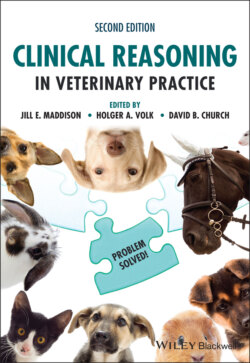Читать книгу Clinical Reasoning in Veterinary Practice - Группа авторов - Страница 48
Pathophysiology
ОглавлениеThe main function of vomiting is to protect the animal from ingested toxins. Dogs in particular have a propensity to eating disgusting things and have a very well‐developed vomiting reflex.
To develop a rational approach to the patient who is reported to be vomiting, it is important to appreciate the pathophysiology of vomiting and regurgitation.
Vomiting or emesis is the forceful expulsion of gastric contents through the oesophagus, mouth and, sometimes, nostrils. It is a neurologically complex process resulting from the synchronised activity of a number of abdominal, pharyngeal and thoracic structures. The act of vomiting is coordinated in the medulla oblongata and cannot occur without a functional vomiting centre. In contrast, regurgitation is a passive process, which involves the retrograde movement of food and fluid from the oesophagus, pharynx and oral cavity without the initiation of reflex neural pathways other than the gag reflex.
The essential neurological components of the emetic reflex are the following:
Visceral receptors
Vagal and sympathetic afferent neurons
Chemoreceptor trigger zone (CRTZ)
Vomiting centre within the reticular formation of the medulla oblongata.
It is important to understand the stages that occur in the act of vomition, as they contribute to the clinical manifestation of vomiting, and this also assists the clinician to differentiate vomiting from regurgitation.
The first stage of vomiting is nausea. In this stage, gastric tone is reduced, duodenal and proximal jejunal tone is increased and duodenal contents reflux into the stomach. The patient often appears depressed, hypersalivates and as a result may exhibit repeated swallowing and/or lip‐licking behaviour.
As an aside, while most patients who vomit will also be nauseous, it is important to recognise that the neural pathways involved in nausea and vomiting are not the same. Indeed, the neural pathways involved in nausea are still not well understood. The clinical relevance of this is that drugs that are effective anti‐emetics may not be effective at reducing nausea. If signs of nausea and food aversion persist once vomiting is controlled, consider adding a drug that has good efficacy against nausea such as ondansetron to the patent’s management. Noting, of course, that the persistence of nausea may also reflect progress of the underlying disease.
The nauseous stage is followed by retching (an unproductive effort to vomit, also known as ‘dry heaves’) and then vomiting. When the animal vomits, the epiglottis is closed and the soft palate presses up against the nasopharynx. The abdominal muscles and the diaphragm contract. The contraction of the abdominal muscles is usually visible to an observant owner. The cardia then opens, the pyloric stomach contracts and vomiting occurs. Reverse peristalsis, cardiac rhythm disturbances and increased colonic motility may also occur during the vomiting process.
The closure of the epiglottis and pressing of the soft palate up against the nasopharynx protect against aspiration of gastric contents. In contrast, during regurgitation, which is a passive process without neurological coordination, these actions do not occur. As a result, aspiration pneumonia is a common sequela to disorders that cause regurgitation and less likely in vomiting unless the animal is obtund.
